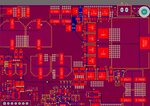Akanimo
Advanced Member level 3

I must say congratulations. I can remember when you almost gave up. It's good you listened and then gave that little final push that you needed to succeed when we all advised.
One major thing that I have realized with the initial calculations is that we were treating your project as if it were an adapter. We should have considered that at the output of a charger we have both an opposing voltage source and a load resistance in series with it. This means that for the required output current, we will have:
Rload=(Vout-Vbatt)/Ichg.
So designing this as an adapter, we have:
Iout = Vout/Rload.
This makes the design output current of a charger way higher than that of an adapter for the same design spec.
From the Ichg value, we could calculate peak and average switch currents to determine the sense resistors. So for a charger the sense resistor would definitely be smaller.
Congrats once again on your success!
One major thing that I have realized with the initial calculations is that we were treating your project as if it were an adapter. We should have considered that at the output of a charger we have both an opposing voltage source and a load resistance in series with it. This means that for the required output current, we will have:
Rload=(Vout-Vbatt)/Ichg.
So designing this as an adapter, we have:
Iout = Vout/Rload.
This makes the design output current of a charger way higher than that of an adapter for the same design spec.
From the Ichg value, we could calculate peak and average switch currents to determine the sense resistors. So for a charger the sense resistor would definitely be smaller.
Congrats once again on your success!















